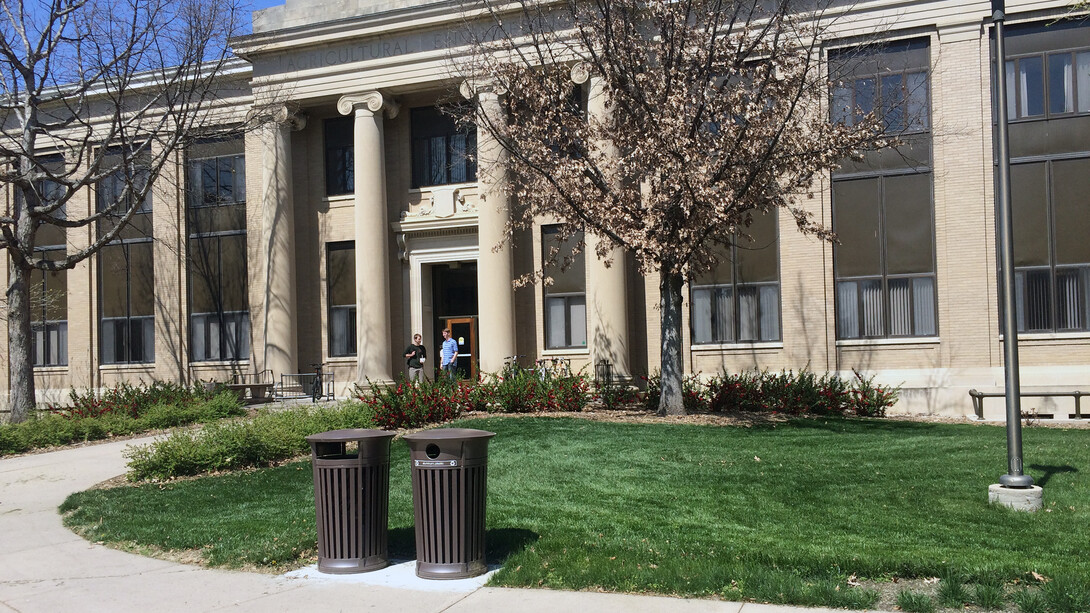
A new University of Nebraska–Lincoln initiative is combining the expertise of police and campus planners to improve public safety and landscape efficiencies by rethinking the design of outdoor spaces.
The initiative incorporates concepts used in crime prevention through environmental design, a theory first developed in the 1960s in Chicago. The theory calls for a multi-disciplinary approach, designing outdoor spaces to be more open to passersby and reducing the odds of unwanted activity.
“The basic idea of this initiative is in the name itself — crime prevention through environmental design,” said Jim Jackson, assistant vice chancellor for facilities operations and maintenance. “Our group, which is a collaboration of university partners, works to identify outdoor areas where safety might be an issue and we redesign those spaces to be more open and inviting.”
Before renovation

After renovation

The work is guided by representation from the University Police Department, landscape services, facilities planning and construction, building systems maintenance and faculty that use campus plantings and landscapes for teaching purposes.
Projects are identified through regular surveys, including an annual nighttime safety walk. All outdoor spaces and the factors that influence them — from weather and time of day to overgrown shrubbery and broken exterior lights — are considered.
Areas of focus include landscape restoration, exterior lighting and signage that assists with wayfinding.
“The function of our university spaces is changing all the time,” said Emily Casper, assistant director of landscape services and campus landscape architect. “We have sidewalks and building entrances that were not high traffic areas 15 years ago. Today, they are main walkways and primary access points.”
Regular assessments help planners readily identify changes in traffic patterns and pivot outdoor designs to meet current demands.
“Improving safety is a key component of this initiative, but we also want these spaces to be aesthetically pleasing,” Casper said. “It’s about cleaning up our outdoor spaces to create a balance between function, aesthetics and safety.”
Goals of the initiative include restoring existing landscapes with a focus on safety, maintaining plant diversity, improving water conservation, advancing storm water management, and maintaining/expanding landscapes for teaching and student engagement.
Many of the completed strategic design for crime prevention projects have involved the removal of overgrown shrubs and upgrading lights along sidewalks and building entrances. Some of those efforts include the front entrance of Chase Hall; the north façade of the East Union; south sides of Canfield Administration Building, Love Library and Nebraska Union; and the 12th Street mall.

“Strategic design concepts are also being integrated into planning and construction guidelines for current and future projects,” Casper said. “We’re looking at how buildings are designed so they don’t create recessed areas and other trouble spots. Lighting and landscape designs are also being considered.”
University Police Capt. John Backer said the initiative is a model of how first responders and campus planners should collaborate.
“This initiative is an example of modern policing in action,” Backer said. “It’s about different viewpoints coming together to be proactive and increase public safety.”
The initiative also makes landscaping maintenance more efficient, reducing pruning needs by integrating trees, shrubs and flowers that grow at slower rates or remain closer to the ground.
Jackson said that the initiative is a shift in how the university approaches landscape design.
“We’re working together across disciplines to better plan and develop landscapes that are safer and more efficient while maintaining that look everyone enjoys,” Jackson said. “There are many components that go into this type of landscape design. But the extra effort is worthwhile as it helps increase the confidence and feeling of safety individuals have when they are on campus.”








